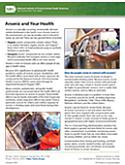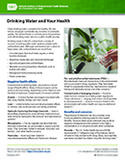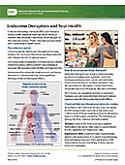Introduction

Drinking water in the U.S. comes from a variety of sources, including public systems, private wells, and bottles. Although mechanisms are in place to keep water safe, contamination can result from:
- Agricultural pesticides and fertilizers.
- Corroded pipes that leach lead, copper, or other harmful chemicals.
- Hazardous waste sites and industrial discharges.
- Naturally occurring hazardous chemicals, such as arsenic and radon.
- Plastic containers.
- Sewage and food processing waste.
Health Effects
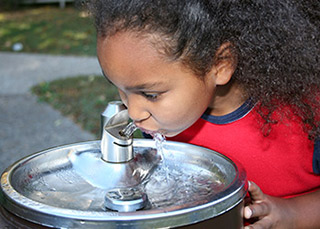
Contaminated drinking water can produce a broad range of health effects. Many can be severe and long-lasting, depending on the chemical and the level of exposure. Contaminants of concern include:
- Arsenic — A known human carcinogen associated with skin, lung, bladder, kidney, and liver cancer.
- Lead — Linked to behavioral and developmental effects in children, and cardiovascular and kidney problems.
- Hydraulic fracturing (fracking) chemicals — Used in the drilling of petroleum, some of these chemicals have been linked to damage to the immune and reproductive systems.
- Microplastics — Can be ingested and absorbed into the body where they can accumulate in organs and the brain. They have been linked to reduced immunity, fertility, and other health concerns.
- Pesticides — Have long been linked to neurodevelopmental effects and Parkinson’s disease.
- Per- and polyfluoroalkyl substances (PFAS) — Manufactured chemicals that endure in the environment and accumulate in living organisms. They have been linked to suppressed immunity, reproductive concerns, kidney and testicular cancer, and other concerns.
- Pharmaceuticals — Prescription and over-the-counter drug residues find their way into ground and drinking water via wastewater systems and urban runoff. The effects of these substances vary greatly, depending on the chemicals and their concentrations.
What is NIEHS Doing?
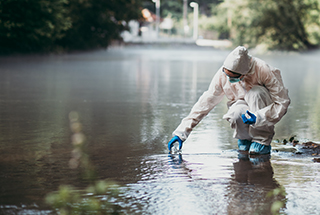
NIEHS research examines potential health effects of contaminants in water and explores ways to protect the public from contact with unsafe water. Recent projects supported by NIEHS have:
- Developed models that estimate wastewater discharges may expose more than 23 million Americans to drinking water with PFAS chemical levels that exceed regulatory thresholds.
- Documented the presence of heavy metals, pharmaceuticals, disinfection by-products, and other contaminants in public water systems throughout the United States.
- Found that highly absorbable nanoplastics may be found in bottled water in much higher concentrations than previously suspected.
- Shown that events like hurricanes can contribute to elevated levels of pesticide contaminants in drinking water.
- Studied groundwater contamination and public health impact of the 2023 train derailment and chemical spill in East Palestine, Ohio.
NIEHS Superfund Research Program (SRP) grants support study of health effects of potentially hazardous substances as well as clean-up of hazardous waste sites. SRP funds have supported numerous efforts to protect waterways and drinking water.
- A partnership between the University of Kentucky and communities in the Appalachian region of the state seeks to reduce levels of disinfection by-products in drinking water.
- Dartmouth College scientists examined the sources of arsenic in New Hampshire’s drinking water, spurring a state law that lowered allowed limits.
- Researchers at the University of California, Berkeley created an interactive, web-based Drinking Water Tool that documents water quality in communities throughout California.
- Scientists from Texas A&M University and the University of Connecticut have developed strategies to trap PFAS in soil to prevent its spread into water supplies.
- The Superfund Research Center at the University of North Carolina at Chapel Hill successfully encouraged the state Real Estate Commission to include well water quality information on home sale disclosure forms. Researchers also are developing a filtration device to remove arsenic and other chemicals from well water, an innovation that promises to benefit up to 3 million state residents.
- University of Iowa researchers have devised a method to clean harmful polychlorinated biphenyls (PCBs) from aquatic ecosystem, using biochar — a material made from bacteria and corn kernel ashes.
NIEHS also awards Small Business Innovation Research and Small Business Technology Transfer to support private industry advances that reduce the dangers of contaminated water. Successes of the program include:
- ANDalyze sensors detect heavy metals like cadmium, copper, and uranium in water supplies.
- Cyclopure test kits and filtration systems help identify and remove PFAS chemicals from drinking water.
- NanoAffix detectors support real-time, on-site detection of lead in tap water with a hand-held format.
Further Reading
Stories from the Environmental Factor (NIEHS Newsletter)
- Water Treatment Technology Aims to Destroy PFAS On-Site (November 2024)
- Long-Term Study Assesses Drinking Water Quality and Potential Health Risks Post-Hurricane Maria (November 2024)
- Well Water Test History Must Now Be Shared With Home Buyers (July 2024)
- Microplastics’ Knowns, Unknowns Discussed by a Physician-Scientist (May 2024)
- Ask the Expert: How Does NIEHS Research on PFAS Affect Me? (May 2024)
- Oceans Research Gets New Funding (May 2024)
- Grantee Shines New Light on Cause of Ciguatera Seafood Poisoning (April 2024)
- Water Contaminants Identified, Addressed in Marginalized Communities (October 2023)
- Stricter Drinking Water Standards for Arsenic Benefit Highly Exposed Populations (September 2023)
- Microplastics Research: Sum of Our Exposures Studied by Grantee (July 2023)
- Geospatial Analysis Shows Disproportionate Exposure to Arsenic and Uranium Across the U.S. (February 2023)
- PFAS Water Filter Developed Through NIEHS Funding (April 2022)
- Eight Substances Added to 15th Report on Carcinogens (January 2022)
- Water Contaminant NDMA Linked to Cancer Cluster in Massachusetts (May 2021)
Printable Fact Sheets
Fact Sheets
Press Releases
- Microplastics, Algal Blooms, Seafood Safety Are Public Health Concerns Addressed by New Oceans and Human Health Centers (April 16, 2024) - NIEHS and the National Science Foundation jointly fund research centers to better understand how ocean-related exposures affect people’s health.
Podcasts
- Reducing Exposure to Disinfection Byproducts in Drinking Water (2023) – Before drinking water reaches a home, it is treated with chlorine to kill bacteria, viruses, and germs that can cause disease. Although this disinfection step keeps people safe from waterborne illnesses, it also has the potential to create byproducts that can harm health. These compounds – called disinfection byproducts – are formed when chlorine combines with organic matter naturally present in water. NIEHS-funded researchers work with residents in eastern Kentucky who are concerned about high levels of disinfection byproducts detected in their drinking water.
Additional Resources
- Water, Sanitation, and Hygiene (WASH) Collection – In the U.S., safe piped water is responsible for improving public health. Yet billions of people globally—including some residents of high-income countries—lack access to safely managed drinking water services. This collection of research papers published in Environmental Health Perspectives is related to WASH topics.
- Medline Plus: Drinking Water – Consumer information from Medline Plus, a service of the National Library of Medicine.
- CDC: Drinking Water – Public health information from the Centers for Disease Control and Prevention.
- Ground Water and Drinking Water – Information from the U.S. Environmental Protection Agency.
- Reducing PFAS in Drinking Water (1MB) – In the Cincinnati area, NIEHS-funded researchers discovered high levels of a specific PFAS chemical, called perfluorooctanoate (PFOA), in young girls. This research translation story shows how they worked with local water departments to implement water filtering techniques that resulted in a 40-60% reduction in PFOA levels in the girls and other residents.
- Report on Carcinogens – This congressionally mandated, science-based, public health document is prepared by NTP for the HHS Secretary. The current report lists 248 agents, substances, mixtures, and exposure circumstances that are known or reasonably anticipated to cause cancer in humans.



